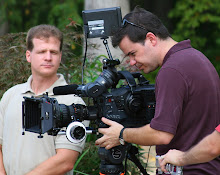
I've been shopping around for a new smallish-HD camera (the Sony EX-1 is the current top contender) and it got me thinking about how we're in an era now where there really isn't a dominant HD tape format, the way Betacam SP used to be in the analog days, and it's quite likely there never will be one again. Of course, I'm dating myself merely by using the term, "tape format," since there probably will never be any new professional video tape formats. Data formats, yes, codecs, yes, but the days of running strips of rust-coated plastic by spinning tape heads are coming to and end, slowly but surely.
Back in the late 80s and through the 90s Betacam SP was the dominant, universal tape format. Everybody had it, and the quality was high enough that most felt is was acceptable for mastering. Digital Betacam, or "digibeta," as we used to call it, was a (surprise!) digital version of Betacam SP, with measurably higher quality. Problem was, digibeta decks were around forty grand each, making them a tough sell for many smaller shops like ours. And Sony, in a classic "let's protect our high end products and in the process keep ourselves from owning the larger market" move, never introduced a more affordable digibeta deck. Shops like mine were begging for a simple digibeta player/recorder, something that could be controlled by a nonlinear system (remember, this is the mid-90s, so non-linear systems were still in their adolescence...), but all Sony offered was a full-featured deck with all kinds of cool stuff broadcasters needed, but that was overkill for hosing up to a nonlinear editing system.
In the mean time, Sony released the UVW series Betacam SP decks, which were affordable (under ten grand, as I recall) and perfect for nonlinear systems. They sold like crazy, and further cemented Beta SP as the universal format for analog video. They're video wasn't as clean as the broadcast-level BVW-series decks, but for many users that didn't matter. As long as you could hand over a Beta SP tape, you were good to go. (Actually, with some of the early nonlinear systems the noisier UVW decks yielded better final video quality, because the noise in the signal helped prevent banding.)
But time marches on, and soon digital formats started to gain popularity. miniDV was huge hit with pros and consumers alike, Panasonic made major inroads in TV news and the general production world with DVCPro, followed by DV50, which delivered digibeta quality at a fraction of the price (and was our in-house mastering format for many years). Sony released DVCAM, a DV variant, but claimed it was an "industrial only" format at first - true pros would never lower themselves to use anything other than digibeta for broadcast work, according to the Sony literature of the day. The tragically named Digital-S, later rebadged D9, was a great format (technically comparable to DV50) but large physical tape sizes and being JVC-only really kept it from catching on.
Still trying to protect Digital Betacam at the high end, Sony released Betacam SX, a lower bitrate digital format. It suffered from image quality problems and never caught on, although a number of news stations used it for a few years. In the mean time, Panasonic's DVCPro/DV50 cameras continued to win market share from folks who years earlier would have laughed at the idea of using anything but a Sony camera. (One of my college professors had a funny, fake ad on his bulletin board. It said: Sony - Because everything else is crap. And at the time it was true.)
Enter HD, memory cards, disk recording...and here we are, with tape formats becoming less important, and your shop's internal IT infrastructure and digital archiving strategies becoming vital. (We'll address those issues in more detail in future posts.) Heck, one of the things I like about buying a Sony EX-1 is that I won't have a buy a deck to go with it!
Still, through it all, it's fun to look back and reflect on how easy it was, back when having a Betacam SP deck meant you never had to worry about compatibility when exchanging tapes.
What do you think? Have any fond memories of tape formats from long ago? Still pine away over the sound of a 1" machine coming up to speed? Share your thoughts in our comments section!


1 comment:
The EX-1 is awesome. However, it needs a shoulder brace to help with the handholding. I went looking around the web for one and found this one
http://www.studio1productions.com/vsb1.htm
The demo video says it's made specifically for the EX-1, but lookis like it would work for other cameras. This site also has an instructional video for the EX-1 at this link
http://www.studio1productions.com/dvd-700.htm
Hopes this information helps other Sony PMW-EX1 owners.
Chris
Post a Comment